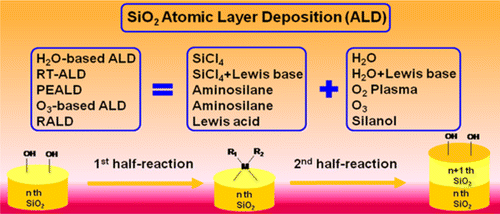当前位置:
X-MOL 学术
›
Chem. Mater.
›
论文详情
Our official English website, www.x-mol.net, welcomes your
feedback! (Note: you will need to create a separate account there.)
Theoretical Understanding of the Reaction Mechanism of SiO2 Atomic Layer Deposition
Chemistry of Materials ( IF 7.2 ) Pub Date : 2016-02-23 00:00:00 , DOI: 10.1021/acs.chemmater.5b04422 Guoyong Fang 1, 2 , Lina Xu 1 , Jing Ma 3 , Aidong Li 2
Chemistry of Materials ( IF 7.2 ) Pub Date : 2016-02-23 00:00:00 , DOI: 10.1021/acs.chemmater.5b04422 Guoyong Fang 1, 2 , Lina Xu 1 , Jing Ma 3 , Aidong Li 2
Affiliation

|
Atomic layer deposition (ALD) is a powerful nanofabrication technique for the preparation of uniform, conformal, and ultrathin films and allows accurate control of the composition and thickness of thin films at the atomic level. To date, ALD has been used for the growth of various materials, including oxides, nitrides, sulfides, metals, elements, compound semiconductors, and organic and organic–inorganic hybrid materials. As one of the most important inorganic materials, silicon dioxide (SiO2) has been used in the fields of microelectronics, catalysis, and energy storage and conversion. Various SiO2 ALD methods have been developed, which have expanded the research and applications of ALD chemistry and technology. Recent advances concerning the reaction mechanisms of SiO2 ALD have further deepened our understanding of the surface chemistry and related catalysis in the ALD of SiO2 and other oxides. Thin films of SiO2 can be obtained by means of thermal ALD and energy-enhanced ALD. Thermal ALD of SiO2 includes H2O-based ALD without a catalyst, room-temperature ALD (RT-ALD) catalyzed by a Lewis base, and rapid ALD (RALD) catalyzed by a Lewis acid. Energy-enhanced ALD of SiO2 encompasses plasma-enhanced ALD and O3-based ALD using aminosilane. In this review, we highlight the significance and advantages of ALD and introduce many methods of SiO2 ALD. Subsequently, theoretical advances concerning reaction mechanisms of SiO2 ALD are summarized. The related catalysis phenomena are highlighted, and their possible applications are speculated upon. Finally, a conclusion and perspective on the catalysis in the ALD growth of SiO2 is provided. It is expected that theoretical research on SiO2 ALD will enhance our comprehension of the chemistry and catalysis pertaining to ALD, provide a guide for the design of more effective Si precursors for SiO2 ALD, and lead to further improvement in the ALD preparation of other oxides and their nanolaminates.
中文翻译:

SiO 2原子层沉积反应机理的理论认识
原子层沉积(ALD)是一种强大的纳米加工技术,用于制备均匀,保形和超薄的薄膜,并且可以在原子水平上精确控制薄膜的组成和厚度。迄今为止,ALD已用于各种材料的生长,包括氧化物,氮化物,硫化物,金属,元素,化合物半导体以及有机和有机-无机杂化材料。作为最重要的无机材料之一,二氧化硅(SiO 2)已用于微电子学,催化以及能量存储和转换领域。已经开发了各种SiO 2 ALD方法,其扩展了ALD化学和技术的研究和应用。SiO 2反应机理的最新进展ALD进一步加深了我们对SiO 2和其他氧化物的ALD中的表面化学和相关催化的理解。SiO 2薄膜可以通过热ALD和能量增强的ALD获得。SiO 2的热ALD包括没有催化剂的H 2 O基ALD,通过路易斯碱催化的室温ALD(RT-ALD)和通过路易斯酸催化的快速ALD(RALD)。SiO 2的能量增强的ALD包括使用氨基硅烷的等离子体增强的ALD和基于O 3的ALD。在这篇综述中,我们重点介绍了ALD的重要性和优势,并介绍了SiO 2 ALD的许多方法。随后,关于SiO反应机理的理论进展总结了2个ALD。突出了相关的催化现象,并推测了其可能的应用。最后,对SiO 2的ALD生长中的催化作用提供了结论和展望。预期对SiO 2 ALD的理论研究将增强我们对ALD的化学和催化的理解,为设计更有效的SiO 2 ALD的Si前驱体提供指导,并导致其他ALD的制备方面的进一步改进。氧化物及其纳米层压板。
更新日期:2016-02-23
中文翻译:

SiO 2原子层沉积反应机理的理论认识
原子层沉积(ALD)是一种强大的纳米加工技术,用于制备均匀,保形和超薄的薄膜,并且可以在原子水平上精确控制薄膜的组成和厚度。迄今为止,ALD已用于各种材料的生长,包括氧化物,氮化物,硫化物,金属,元素,化合物半导体以及有机和有机-无机杂化材料。作为最重要的无机材料之一,二氧化硅(SiO 2)已用于微电子学,催化以及能量存储和转换领域。已经开发了各种SiO 2 ALD方法,其扩展了ALD化学和技术的研究和应用。SiO 2反应机理的最新进展ALD进一步加深了我们对SiO 2和其他氧化物的ALD中的表面化学和相关催化的理解。SiO 2薄膜可以通过热ALD和能量增强的ALD获得。SiO 2的热ALD包括没有催化剂的H 2 O基ALD,通过路易斯碱催化的室温ALD(RT-ALD)和通过路易斯酸催化的快速ALD(RALD)。SiO 2的能量增强的ALD包括使用氨基硅烷的等离子体增强的ALD和基于O 3的ALD。在这篇综述中,我们重点介绍了ALD的重要性和优势,并介绍了SiO 2 ALD的许多方法。随后,关于SiO反应机理的理论进展总结了2个ALD。突出了相关的催化现象,并推测了其可能的应用。最后,对SiO 2的ALD生长中的催化作用提供了结论和展望。预期对SiO 2 ALD的理论研究将增强我们对ALD的化学和催化的理解,为设计更有效的SiO 2 ALD的Si前驱体提供指导,并导致其他ALD的制备方面的进一步改进。氧化物及其纳米层压板。






























 京公网安备 11010802027423号
京公网安备 11010802027423号